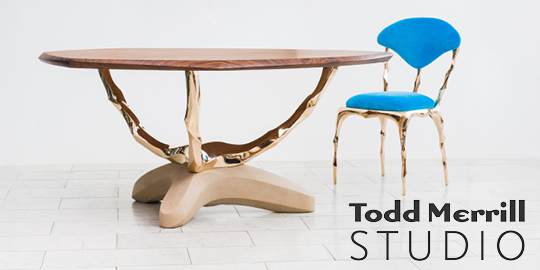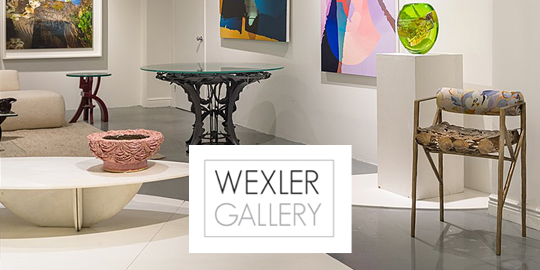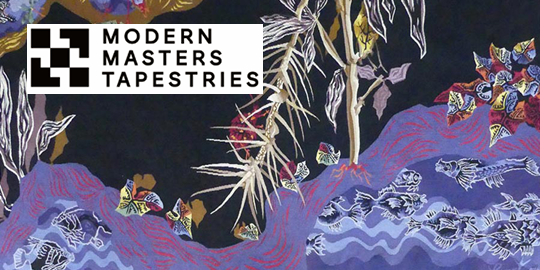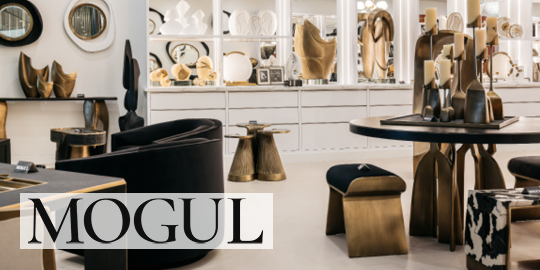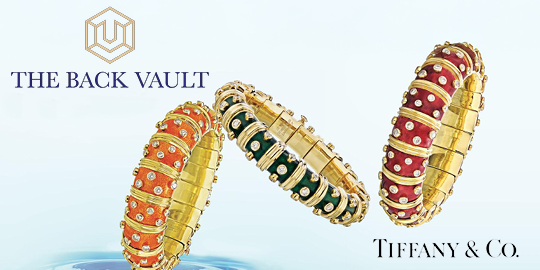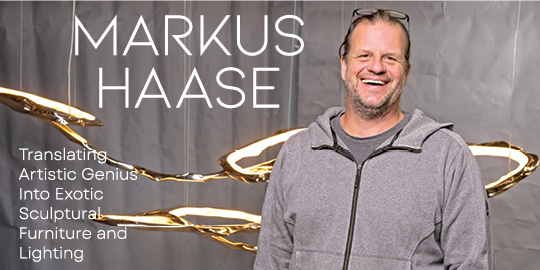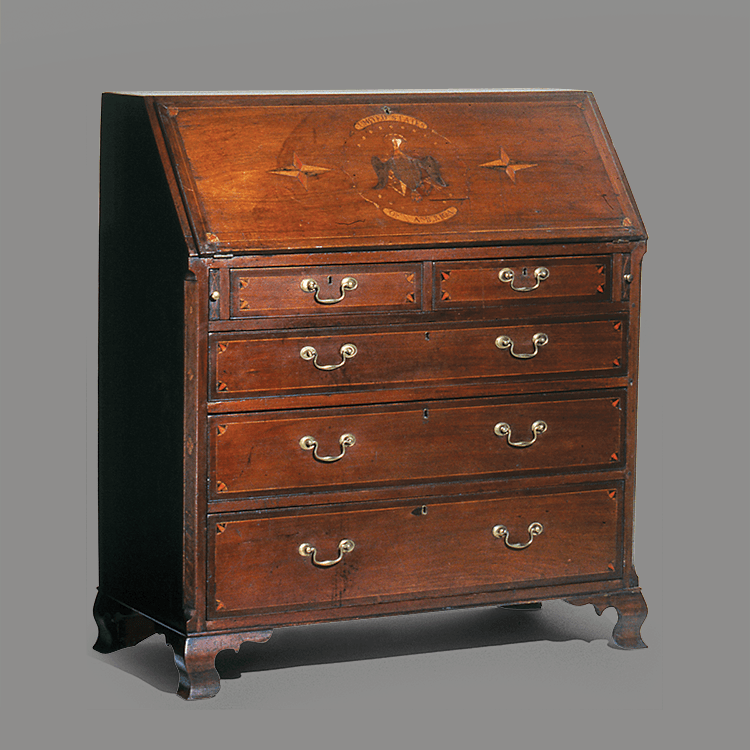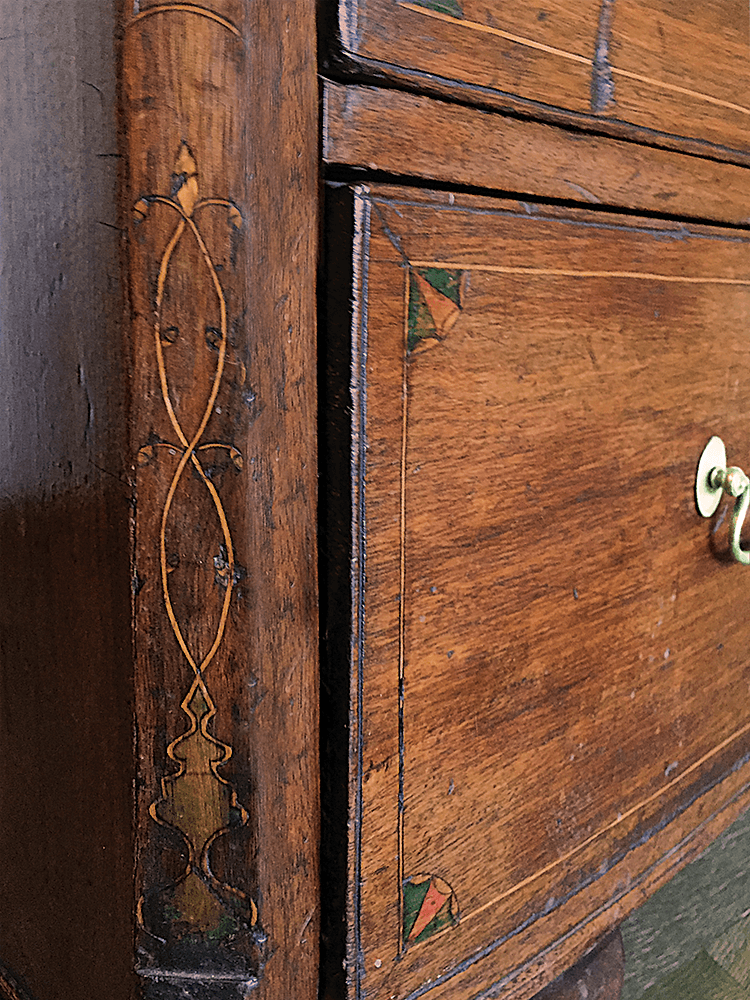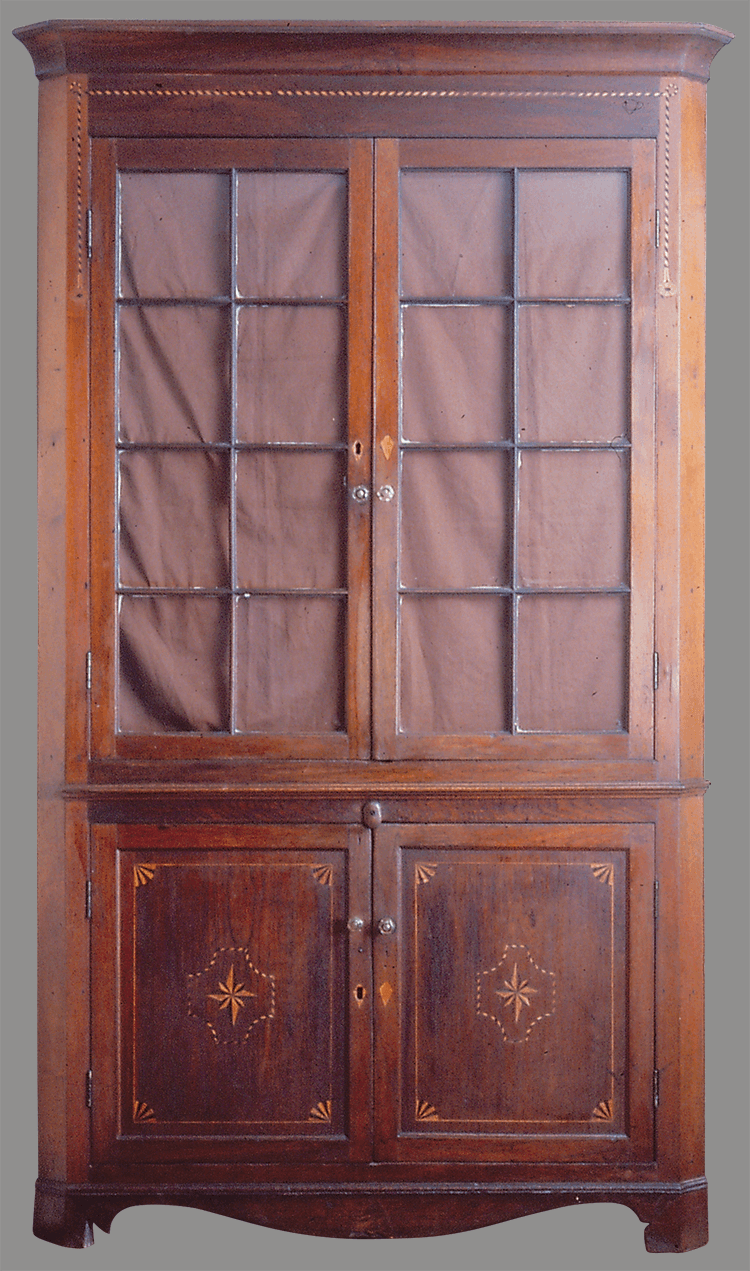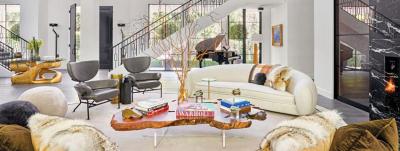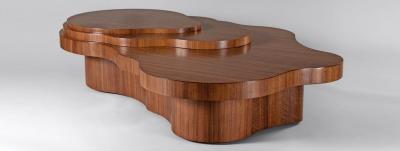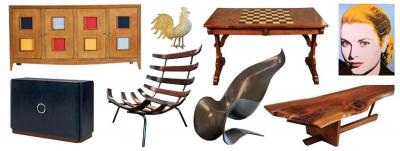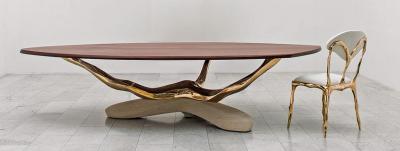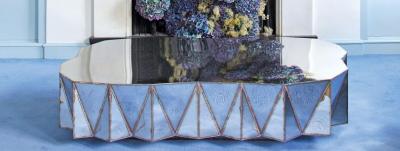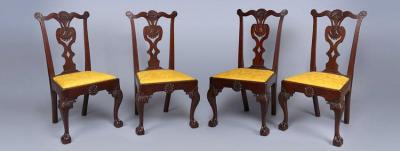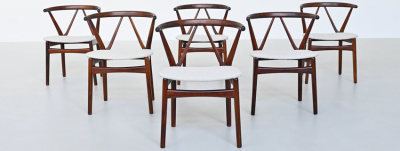Fans, Fish, and Tassels: Idiosyncratic Inlaid Furniture of Northeastern Tennessee
Settlers began arriving in northeastern Tennessee by the late 1760s. By the time Tennessee became the sixteenth state in 1796, there were well-established towns in the northeastern corner of the state bordering Virginia and North Carolina. While there is little extant furniture that predates 1800, by the first decade of the nineteenth century there were cabinetmakers producing fanciful furniture associated with this region. This article is intended to highlight the work of one shop located in Washington County, Tennessee. A second article will make observations on the cross-pollination of the idiosyncratic inlay motifs between this shop and one in Greene County, Tennessee.
A desk in the collection of the Winterthur Museum forms the keystone of a small group of furniture that can now be attributed to Washington County (Fig. 1) based on the discoveries of other furniture from this same shop, discussed below.1 Originally attributed with Piedmont, North Carolina, the shop has more recently been associated with either southwestern Virginia or, more accurately, northeastern Tennessee, where Washington County is located.2
The patriotism of the owner of the desk, or perhaps of the cabinetmaker, is evident in the widespread eagle surrounded by seventeen small stars and the legend “United States of America” flanked by two large stars on the fallboard as well as the bust on the prospect door with the legend “LIBERTY” and the date 1808 (Fig. 1a). The seventeen stars probably represent the number of states at the time the desk was made and correspond nicely to the date on the prospect door; Ohio became the seventeenth state in 1803, and Indiana the eighteenth in 1816. While there is much frolicsome inlay found on East Tennessee furniture, this desk and the group to which it belongs is distinguished by a number of individualized decorative attributes. These include the use of polychromed inlay;3 the manner in which the quarter-fan inlays are made as a single piece and incised with a gouge to create the illusion of separate segments, each tediously colored; inlaid and colored motifs on the canted corners, in this case a trailing bellflower, lozenge, tri-colored diamond, and an intertwined ribbon; and a scratch bead along the edges of the drawer fronts. Other case pieces from this group also share construction characteristics, elaborated below; this desk has the only original feet of any of the furniture shown here from this shop.
The next piece that came to light from this distinctive group is a desk (Fig. 2) now in the collection of the Speed Museum, Louisville, Kentucky. This desk features the same exterior configuration as figure 1, with two over three drawers and canted corners, as well as the same interior arrangement with the wide prospect door and document drawers. This desk once had valances, which are now missing. It also has the same incised and colored quarter fans on the drawers, inlaid ovals, and a ribbon motif at the lower end of the cants (Fig. 2a). One of the interior drawers of this desk bears the name Josiah C. Thompson and the date 1804.4 Scarcely visible in photographs are letters inlaid in the lozenges on the interior drawers and on the document drawers.5
Two chests of drawers with the same two over three drawer composition as the desks, canted corners, and incised and colored quarter fans turned up in the early 2000s. They have drawers with a scratch bead around the edges like the desks and the same molded edge to their tops.6 The inlay on the canted corners of one of the chests repeats motifs seen on the desks, including the inlaid ovals and a trailing bellflower, but adds others (Figs. 3). Most obvious is the inlaid fish with incised scales (Fig. 3a). The incising of the scales on the fish is very similar to the incising used to create the impression of feathers on the eagle on the fallboard of figure 1. Another additional decorative element is the urn inlaid into the base of each canted corner, from which double loops emanate, surmounted by a single bellflower (Fig. 3b); the intertwined loops relate to the inlay on the ends of the lopers on the desk in figure 2.
The inlay at the base of the canted corners of the second of these two chests (Fig. 4) is segmented at a diagonal to better create the illusion of rope in a like manner to the rope inlay on a corner cupboard acquired by the Museum of Early Southern Decorative Arts (MESDA) in 2011 (Fig. 5). The rope and tassel inlay in the cornice of this cupboard (Fig. 5a) is a motif found on numerous cupboards from cabinetmaking shops in several northeastern Tennessee counties. This cupboard, with its now recognizable incised quarter fans that show traces of
color on the drawers, provided key information as to where these pieces were made. It descended in the Murray family of Washington County and its original owner was probably Ephraim Murray (d. 1835), a landowner and surveyor who moved his family to Washington County from Baltimore County, Maryland, in the 1790s. Other corner cupboards without inlay from this shop are known and in private collections; undoubtedly there are also more undecorated chests and desks as well.
One final example from this core group is a sideboard (Fig. 6) known only from photographs at MESDA and in the Decorative Arts Photographic Collection (DAPC) at Winterthur. Despite the alterations to the side bays, the inlay makes this piece worthy of note. The inlaid running astragal pattern on the center drawer relates to the inlay on the prospect door of the desk at the Winterthur (fig. 1), and the inlaid ovals on the stiles are evident on other pieces from this group, and are most closely aligned with the MESDA cupboard doors. More apparent is the relationship of the rope and tassel inlay, which is identical in execution to that on the MESDA corner cupboard. To the author’s knowledge, this is the only sideboard from the region with rope and tassel inlay.7
There are two known pieces of furniture that can be associated with this shop, or an offshoot of it. One of these is a chest (Figs. 7, 7a) with a strong history in the Devault Tavern in the Leesburg community of Washington County and the other is a blanket chest.8 Both have a similarly sized fish to that on the chest of drawers illustrated in figure 3a. As on figure 3a, the fish on figure 7 are swimming upstream, but are very different in character, being much more naïve and having speckled dots created by punch marks rather than scales.9 This chest, which features a two over four drawer arrangement, has the same molding on the edge of the top, the same canted corners, and the same scratch bead on the drawers as the two chests discussed above. Rather than fans at the corners of the drawers, however, there are lozenges.
There were at least eight cabinetmakers working in Washington County before 1830. Demand must have been strong, for in 1819, William Derrick advertised for “six journeymen Cabinet Makers.” 10 Similar decorative motifs seen on the group being discussed were implemented by various cabinetmakers. A desk (Fig. 8) that bears the signature of Thomas Kinnard, for example, features a smaller and much less elaborate eagle on its fallboard. Thomas Kinnard advertised in the Jonesborough, Washington County, newspaper in 1819 that he had opened his cabinetmaking business on Chestnut Street and that he wished to purchase quantities of shaded maple, cherry, poplar and walnut plank.11 Unfortunately, the inlaid disk now seen below the eagle is a replacement perhaps covering up an earlier owner’s initials.
Though the maker of the core group under discussion (figs. 1–6) has yet to be securely identified, at a furniture conference in 2013, Amber Clawson attributed the MESDA corner cupboard to Hugh and Robert McAdams of Big Limestone Creek in Washington County, based on extensive research on the family and the networks within the community. Further connecting the brothers with this cupboard was her discovery of a “profile machine” in the 1815 estate inventory of the shop of Hugh McAdams. A profile machine is the common term for a physiognotrace, which was used for making silhouettes such as the profile bust on the prospect door to the Winterthur desk (fig. 1a).12 The device was purchased after Hugh’s death by his brother and fellow cabinetmaker, Robert. The inventory also contained an extensive listing of the contents of Hugh’s shop, which included numerous tools and a book of architecture, as well as the names of other cabinetmakers in the community.13
There is one other example of furniture from the region known to the author that features an inlaid bust (Figs. 9, 9a). Though the profile recalls the bust in figure 1a, the features of the chest itself are unrelated to the core group. This chest has a simple four-drawer facade, the canted corners terminate differently, the top has a veneered versus a molded edge, and the corner inlays are without incised detail. Though apparently from a different shop, the use of the profile motif confirms the awareness of the fashion for silhouettes and shared decorative techniques among the Washington County shops.14
From yet another shop is a corner cupboard related to figure 5 with an almost identical frieze and cornice, the same heavy mid-molding, and eight light doors; it also features a rope and tassel inlay looped at the corner (Figs. 10, 10a). The formation of the rope and the almost floral design of the tassel with its placement almost at the bottom of the uppermost light in the door, both relate it to and distinguish it from the MESDA cupboard, as do the compass star inlays and inlaid corner fans on the lower doors. This cupboard descended in the Brabson family of Bowmanton, Washington County. While not by the craftsman who built the core group, the maker could be Washington County cabinetmaker John Mercer, whose 1815 estate inventory listed “one note of hand on Thomas Brabson…”, which reflects an association between the two.15
The cabinetmakers of northeastern Tennessee, like their patrons, were largely isolated from the East Coast and even from other parts of the backcountry, as this part of the state was reached only by difficult wagon roads until the arrival of the railroad in the 1830s. The hills and valleys of this remote area were connected to each, however, other by small navigable rivers that allowed for trade and the exchange of ideas. Although no other cabinetmakers used the distinctive polychromed inlay seen on the core group of furniture discussed here, their influence can be seen on other furniture made in the county and in the surrounding area. The second article will discuss furniture made in Greene County, which relates to but differs from this group.
Anne S. McPherson is an independent scholar, furniture historian, consultant, and private dealer based in Nashville, Tennessee.
This article was originally published in the Anniversary 2015 issue of Antiques & Fine Art magazine, a digitized version of which is available on afamag.com. Antiques & Fine Art, AFAmag, AFAnews, and AFA Publishing are affiliated with InCollect.com.
2. The desk was purchased in 1957 by H. F. du Pont from Joe Kindig, Jr., who had purchased it from a dealer in Wytheville, in southwestern Virginia. It forms part of a larger group of furniture made in that region and in northeastern Tennessee with eagles inlaid on the fallboards or prospect doors. Wallace Gusler discussed this desk and how its two-tier drawer arrangement surmounted by deeply inset valenced pigeon holes is characteristic of Delaware Valley style transmitted to the Shenandoah Valley and into both east and middle Tennessee; also transmitted were the style of ogee feet and spurred returns. Gusler also pointed out the extensive inlay on this desk distinguishes it from furniture made in the northern Shenandoah Valley of Virginia. See Wallace Gusler, “Furniture of Winchester, Virginia,” American Furniture (Chipstone Foundation, 1997): 256–62.
3. According to Catherine Matsen, “The FTIR spectrum is labeled “wood finish” and indicates the presence of a wax, possibly beeswax. Copper is the major element detected in the XRF spectrum of the green colorant, suggesting the pigment may be verdigris, atacamite, or malachite. Mercury is the major element detected in the area of red colorant which indicates the presence of vermilion. Peaks for lead in this area suggest red lead may be present as well. Weak x-ray lines for potassium, calcium, manganese and iron are detected in both the green and red areas to suggest minor amounts of clay, chalk or gypsum, umbers and/or iron oxides in the colorants as well.” Winterthur Internal Report AL5983.1957.1099, fall front desk with colored inlay.
4. Thank you to Sumpter Priddy III for initially bringing this desk to my attention. The only Josiah C. Thompson I have been able to locate was a Josiah C. Thompson who married Mary Miller in Washington County in 1853. He may have been a descendent of the original owner, or have made a later inscription in the desk. This desk has a history of being acquired in Lexington, KY, by an antiques dealer and was purchased by collectors who gifted it to the Speed Museum with the assumption that it was made in Kentucky. It is now associated with this group from Tennessee.
5. The meaning of these letters is unclear. On the proper right side the letters are “OO,” and “AA” on the top two proper right drawers, and “YY” on the lower larger drawer. There is a “W” in the proper right document drawer and a “D” on the proper left. The drawers on the proper left bear “EE,” “NN,”’ and “II.”
6. One of these chests was purchased in Missouri; the other was purchased from Eastman’s Antiques in Bristol, Va. (on the border of northeastern Tennessee) in the mid-twentieth century.
7. The dealer who owned the sideboard inserted a small notice into Antiques Magazine (April 1981): 917, that he had in inventory “an exceptional Tennessee cherry sideboard with rope-and- tassel inlay motif on all six legs.” Thanks to Amber Clawson for bringing this sideboard to my attention.
8. The other piece with the dotted fish is a blanket chest over drawer on frame. The fish is found in the skirt flanked by circles with incised fan lines. Thanks to Mary Jo Case and Mack Cox for bringing these chests to my attention; the blanket chest is in a private collection in Paris, KY.
9. There is no evidence as to what the fish motif could have meant. Perhaps it was religious, perhaps it referenced gaming, the fish form having been used as a counter in card games of the period.
10. The documented cabinetmakers are Abraham Bayless, Samuel Bruen, William Derrick, Thomas Kinnard, John Mercer, David Stuart, and brothers Hugh and Robert McAdams. See the two published checklists of Tennessee cabinetmakers: Ellen Beasley, “The Tennessee Cabinetmakers and Chairmakers Through 1840,” in Antiques Magazine 100, no. 4 (October 1971): 612–621; and Derita Coleman Williams and Nathan Harsh, “The Art and Mystery of Tennessee Furniture and its Makers, Through 1850” (Nashville: Tennessee Historical Society and Tennessee State Museum Foundation, 1988), 271–323. Additional cabinetmakers can be found in the MESDA Craftsman Database.
11. The entire advertisement reads: “NOTICE. The subscriber respectfully informs his friends and the public generally, that he has commenced business in the CABINET LINE, the shop formerly occupied by Mr. Abraham Bayless, on Chesnut [sic] street, where he will carry on in all various branches of his trade, and hopes to give general satisfaction by having work executed in the neatest style and latest fashion. THOS. K.KINNARD Jonesborough, Nov 15, 1819. P.S. He wishes to purchase a quantity of shaded Maple, Cherry, Poplar, & Walnut Plank. East Tennessee Patriot, Jonesborough, TN, November 30, 1819.”
12. Thanks to Anne Verplanck for the information about profile machines.
13. Lecture given at the 2013 Williamsburg Antiques Forum. Amber Clawson is a graduate student at Middle Tennessee State University in the Public History doctoral degree program. Her research project when at MESDA’s summer institute was furniture with rope and tassel inlay, with the cupboard (fig. 5) as the centerpiece. Additional insights into her work will be found in a future issue of the Journal of Early Southern Decorative Arts. Clawson has done extensive research into the McAdams family and followed its path of migration west to Missouri and then to California. It is interesting to note that the chest in figure 4 (detail shown) was purchased in Missouri.
14. Two chests of drawers with simulated columns and the chest with the profile bust (Fig. 10) all feature an inlaid variegated fan in their shaped skirts, a feature commonly found on chests from northeastern Tennessee as well as other areas. A related chest with simulated columns formed by inlay and a variegated fan in its shaped skirt was recorded by the William King Museum, Abingdon, Virginia, in the course of field research. It had a history in a family from just over the Tennessee line in Washington County, Virginia (ID Number WA–249–01).
15. MESDA Craftsman Database.





